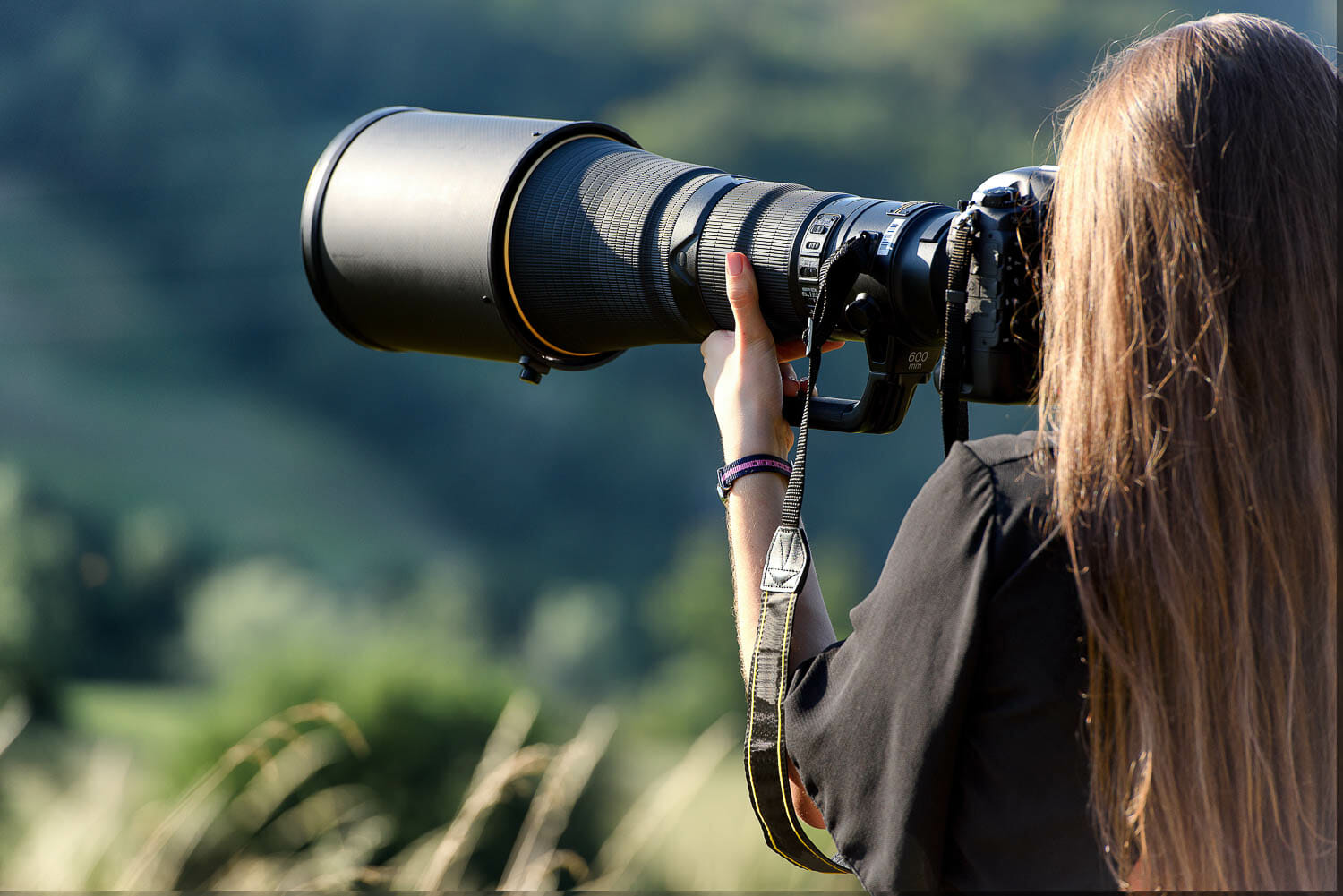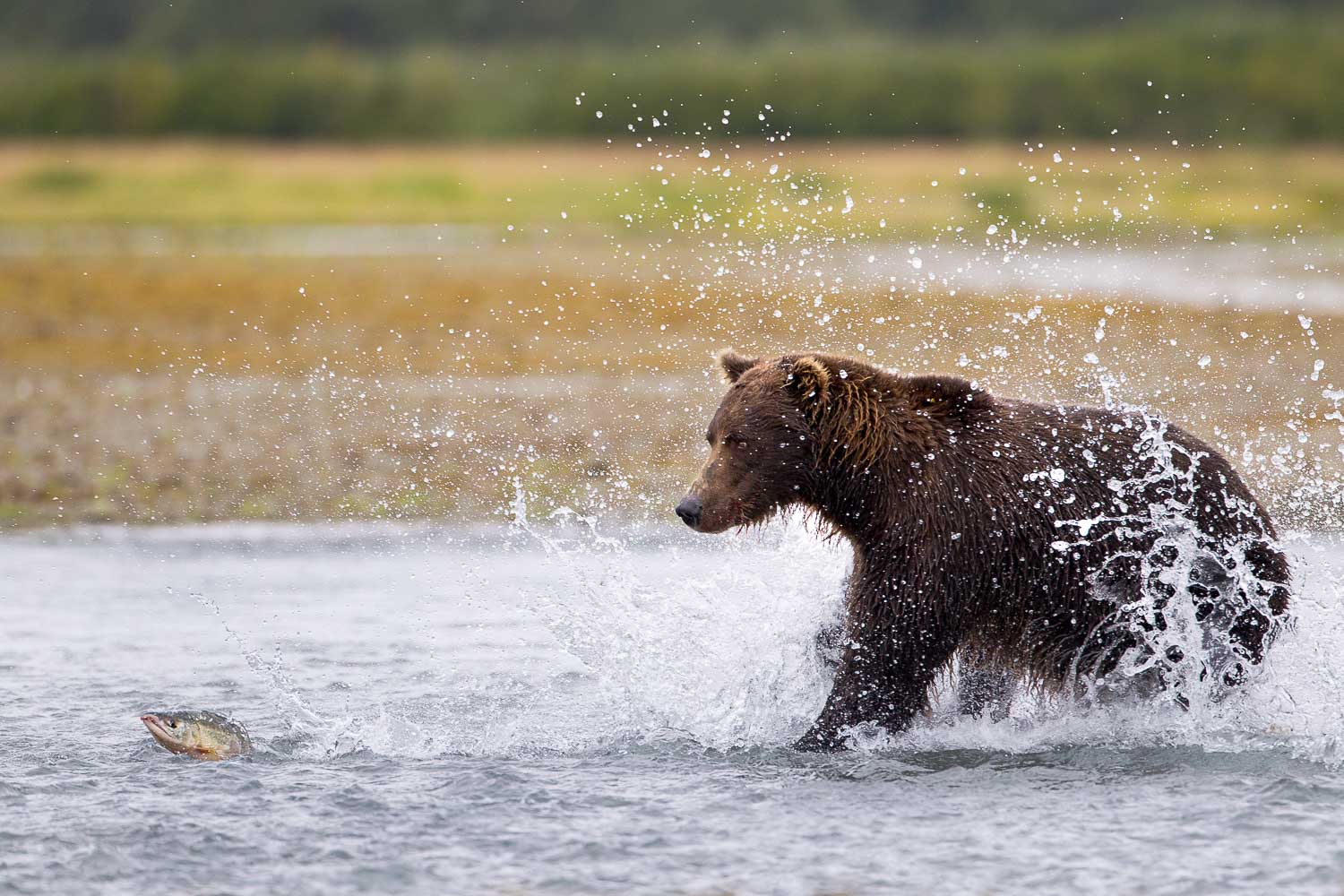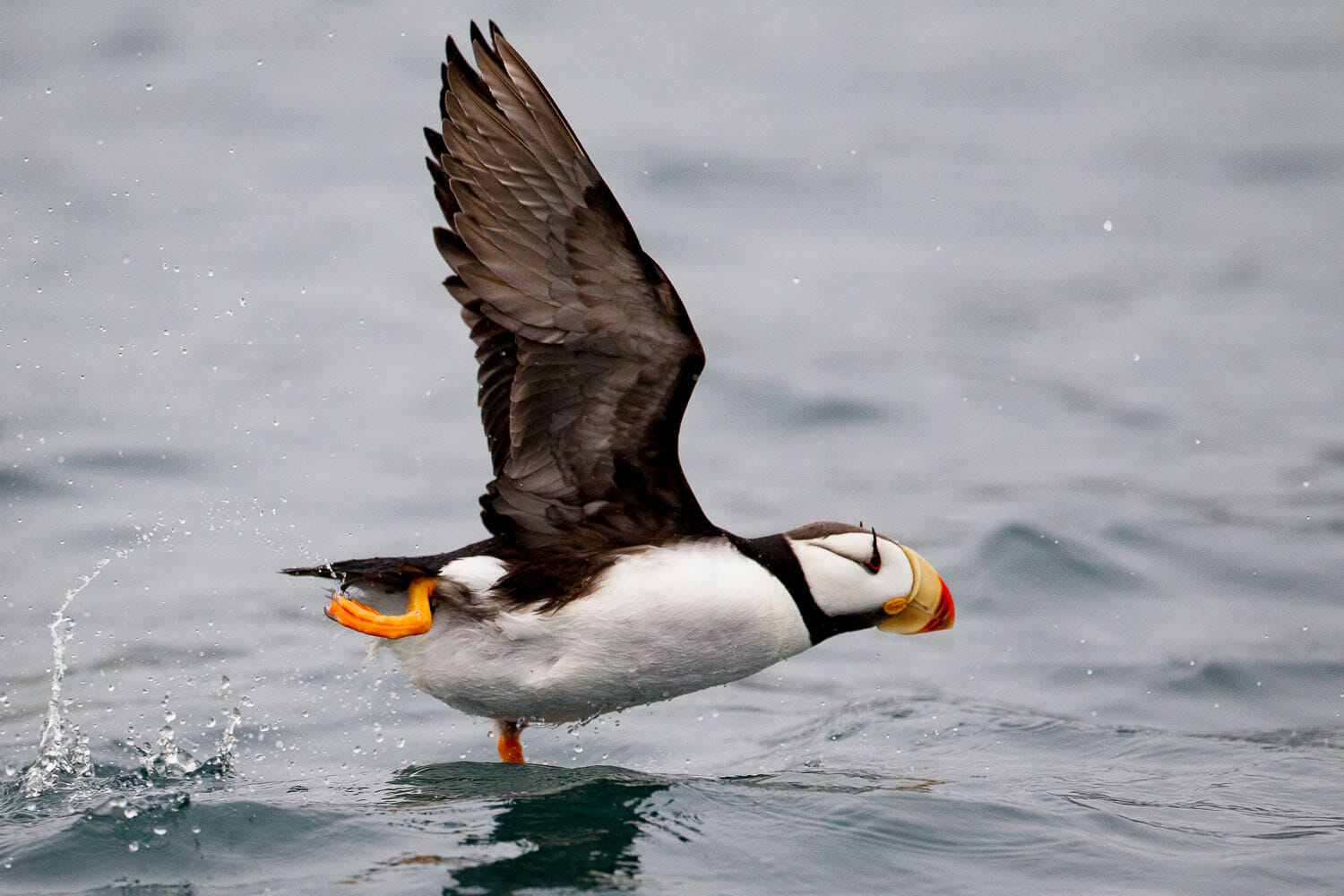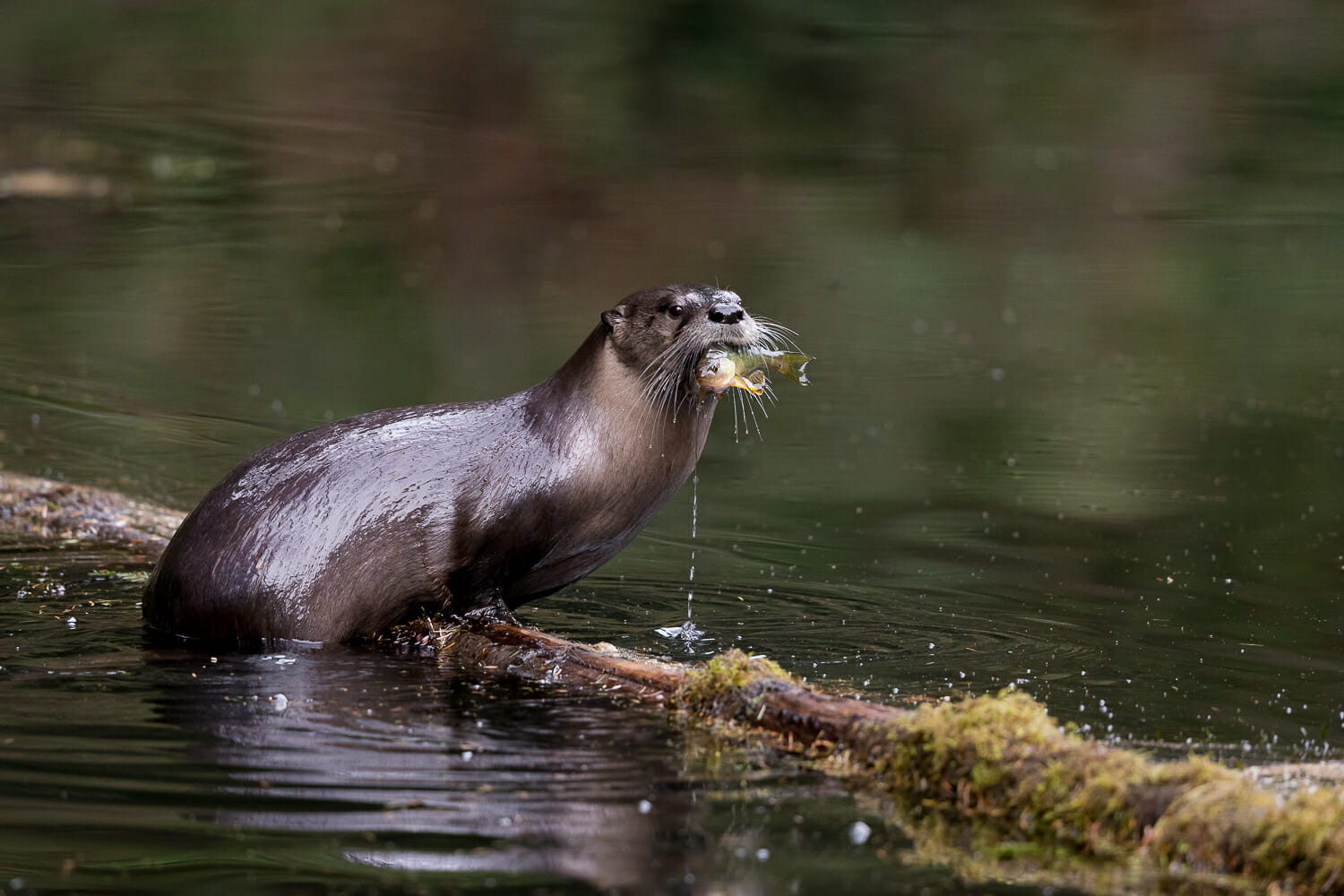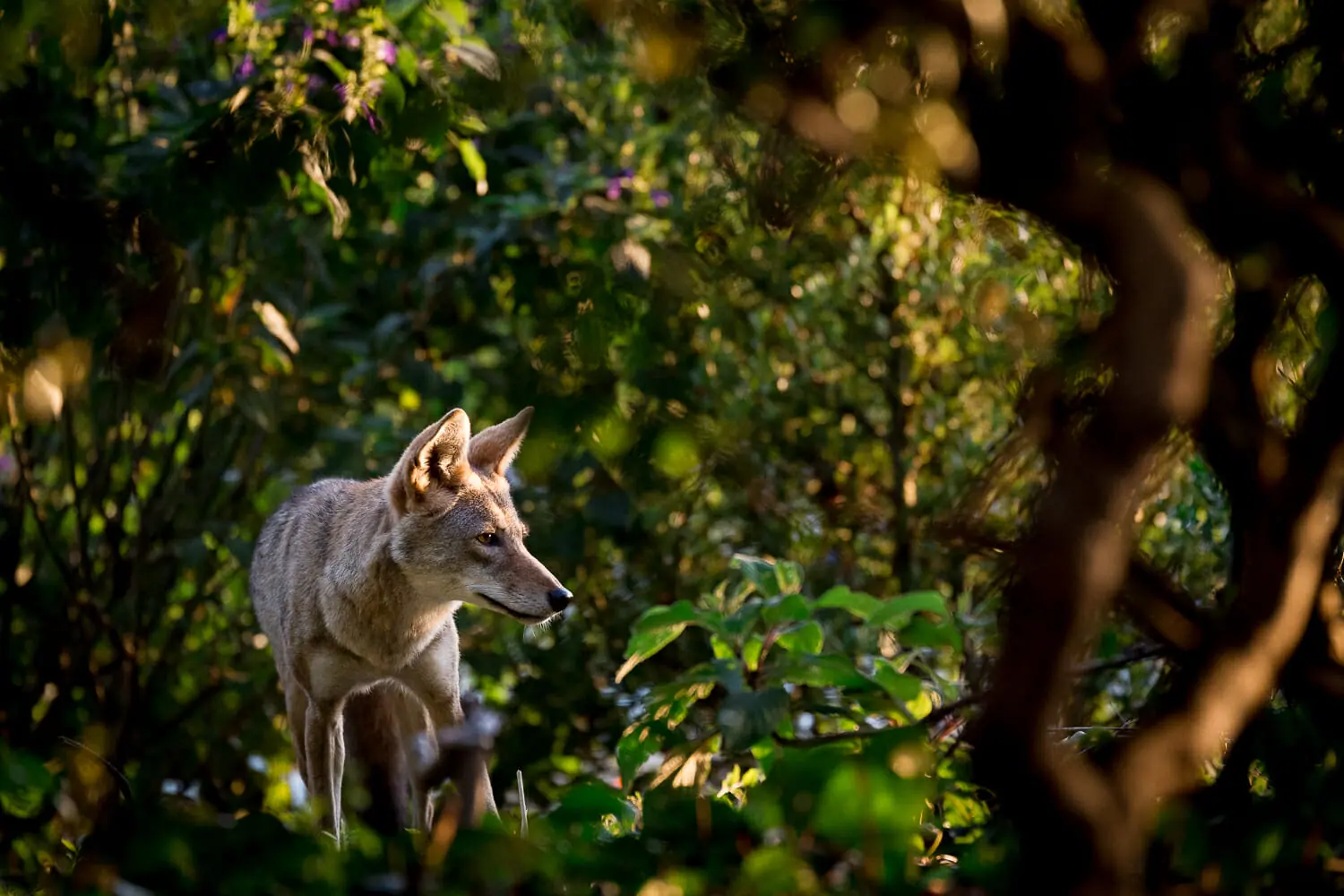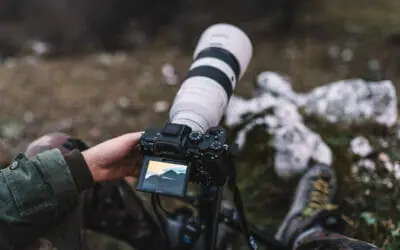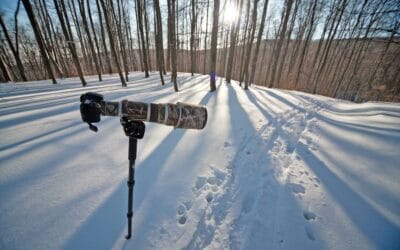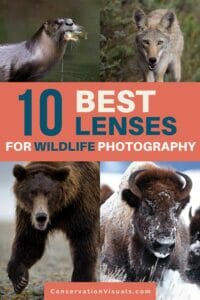Contents
- How we picked
- Canon EF 100-400mm
- Canon EF 600mm
- Canon EF 200-400mm
- Nikon AF-S Nikkor 200mm-500mm
- Nikon NIKKOR Z 400mm
- Sony FE 200-600mm
- Sony FE 70-200 mm
- Tamron SP 150-600mm
- Sigma 150-600mm
- Olympus 40-150mm
- What to look for
- Difference between zoom and prime
- Which types of lenses are best?
- Certain lenses for certain wildlife?
- How to choose
Feature photo by Giuliano Bianchini/Shutterstock
If your passion is capturing the beauty of wild animals or the grace of birds in flight, the first step is finding the best wildlife photography lens to match your needs.
It could be a fantastic lens offering superior clarity and speed, or perhaps you're searching for budget lenses that offer great value for money.
Regardless of your specific needs or budget, we're here to guide you through the vast array of options.
So, let's dive in and uncover the ideal lens to help you elevate your wildlife photography game.
Contents
- How we picked the best lenses for bird photography
- Canon EF 100-400mm F/4.5-5.6L IS II USM
- Canon EF 600mm F/4 L IS III USM
- Canon EF 200-400mm f/4L IS USM Extender 1.4x
- Nikon AF-S Nikkor 200mm-500mm F/5.6 ED VR
- Nikon NIKKOR Z 400mm f/4.5 VR S
- Sony FE 200-600mm F/5.6-6.3 G OSS
- Sony FE 70-200 mm F2.8 GM OSS II
- Tamron SP 150-600mm G2 F/5-6.3 Di VC
- Sigma 150-600mm f/5-6.3 DG OS HSM Contemporary
- Olympus M. Zuiko 40-150mm F/2.8 PRO
- What to look for when shopping for a wildlife lens
- What's the difference between a zoom lens and a prime lens? What about a super telephoto lens?
- Which types of lenses are best for which types of wildlife photographers?
- Are certain types of lenses better for certain types of wildlife? How so?
- How to choose the best wildlife lens for YOU
How we picked the best lenses for wildlife photography
We at Conservation Visual Storytellers Academy have extensive experience in nature and wildlife photography. Our writers and editors use the major camera systems available and have decades of experience in the field.
To choose the best recommendations for you, we combine personal experience, insights from fellow pros and industry experts, editorial and user reviews, and details from manufacturers. We carefully weigh the pros and cons of each item and put only what we feel is the best selection available into our recommendation guides.
We've curated a selection of lenses meant to meet the needs of different photography goals and budgets. Factors we take into consideration for choosing such a lens include weight, image stabilization, low-light performance, and autofocus capabilities.
We also included a mix of entry-level and professional lenses, as well as lenses that are compatible with multiple camera systems. And, of course, since most successful wildlife photography means having a long lens to respectfully and ethically photograph subjects at a distance, we zeroed in on lenses that offer plenty of reach.
For advice on what to consider in a wildlife photography lens and how to choose the right lens for you, use the table of contents to jump to those sections.
Best Lenses for Wildlife Photography: Our Reviews & Recommendations
1. Canon EF 100-400mm F/4.5-5.6L IS II USM
Best affordable zoom lens for Canon camera users
- Versatile zoom range
- Advanced image stabilization
- Fast and silent autofocusing
- Compact and lightweight compared to many super-telephoto lenses
- Weather-sealed construction
- Impressive clarity and color accuracy
- Compatible with Canon's x1.4 and x2 extenders,
- Relatively affordable
- Variable aperture may limit low-light performance
- Extender use may degrade image quality
- Potential for lens creep
- Compatibility: Canon EF DSLR/mirrorless with EF-RF Adaptor
- Stabilization: Yes
- Maximum Focal Length: 400mm
- Aperture: f/4.5-38
- Weight: 3.6 lbs
- Dimensions: 7.6 by 3.7 inches
- Minimum Focusing Distance: 3.2 feet
- Filter Size: 77mm
- Prime/Zoom: Super Zoom Telephoto
WHAT WE THINK
The Canon EF 100-400mm f/4.5-5.6L IS II USM lens hits the sweet spot of performance, portability, and price for those seeking a versatile telephoto lens option with a compact construction that does not compromise on brilliant resolving power.
The incorporation of one fluorite and one Super UD element ensures impressive contrast and resolution, considerably reducing chromatic aberration across the entire zoom range. The Air Sphere Coating reduces backlit flaring and ghosting, and a 9-blade circular aperture results in attractive, soft backgrounds, while the 3-mode Optical Image Stabilizer accounts for up to 4 steps of image correction.
Other features include a rotation-type zoom ring with adjustable zoom torque for precise composition and balance when handholding, a redesigned tripod mount, and a new lens hood with a side window for easy adjustment of specialty filters.
All this, combined with rugged construction and advanced dust and water sealing, the Canon EF 100-400mm f/4.5-5.6L IS II USM is a trusty sidekick for wildlife photography adventures.
BEST PRICES
2. Canon EF 600mm F/4 L IS III USM
Best prime telephoto lens for Canon camera users
- Superior optical quality
- Optical image stabilization
- Fast and silent autofocusing
- Extensive weather sealing
- Compatible with Canon's x1.4 and x2 extenders
- Hefty price tag
- Lighter than old versions, but still hard to handhold for long periods
SPECIFICATIONS
- Compatibility: Canon EF DSLR/mirrorless with EF-RF Adaptor
- Stabilization: Yes
- Maximum Focal Length: 600mm
- Aperture: f/4-32
- Weight: 6.71 lbs
- Dimensions: 6.6 x 17.6 inches
- Minimum Focusing Distance: 13.78 feet
- Filter Size: 52mm
- Prime/Zoom: Prime
WHAT WE THINK
The Canon EF 600mm f/4L IS III USM is beloved by professional photographers and advanced amateurs alike. The lens features hlep minimize chromatic and spherical aberrations, resulting in accurate rendering and color fidelity, and its Super Spectra and Air Sphere Coatings help reduce ghosting and flare, ensuring brilliantly clear photos.
A customizable electronic focusing ring alongside a robust ring-type Ultrasonic Motor ensures quick, quiet, and precision autofocus performance, while two focus presets allow quick and intuitive handling. The lens also supports full-time manual AF, providing photographers with flexibility. On top of all that, the lens features a five-stop-effective Image Stabilizer system with three separate modes to cater to varied shooting applications.
Dust- and water-resistant, with fluorine coatings for added protection in harsh conditions, and heat-rejecting paint and a two-layer barrel structure expand its usability across a range of conditions.
Despite its high price point, this impressive piece of equipment is the go-to for many serious wildlife photographers.
BEST PRICES
3. Canon EF 200-400mm f/4L IS USM Extender 1.4x
Best high-end zoom lens for Canon camera users
- Built-in 1.4x extender
- Advanced image stabilization
- Quick and silent autofocusing
- Durable construction
- Extensive weather sealing
- Fantastic image quality
- Optical image stabilizer
- Relatively heavy and large
- Variable aperture when using the built-in extender
- Compatibility: Canon EF
- Stabilization: Yes
- Maximum Focal Length: 400mm (560mm with extender)
- Aperture: f/4-32
- Weight: 7.98 lbs
- Dimensions: 5.0 in. x 14.4 inches
- Minimum Focusing Distance: 6.6 feet
- Filter Size: 52mm
- Prime/Zoom: Zoom
WHAT WE THINK
Built to meet the rigorous demands of wildlife photographers, the Canon EF 200-400mm f/4L IS USM features an integrated 1.4x extender, enabling a quick switch from the native 200-400mm f/4 range to an extended 280-560mm f/5.6, an invaluable feature in situations where lens changes aren't feasible or convenient.
The lens construction, with 25 elements in 20 groups (or 33 elements in 24 groups with the extender on), includes a fluorite and four UD lens elements that offer excellent chromatic aberration correction across the zoom range, resulting in high-resolution, contrast-rich, and color-accurate images.
Additionally, the lens bears a 9-blade circular aperture, aiding in delivering soft, appealing backgrounds, and a Super Spectra Coating to reduce ghosting and flare.
The lens also boasts of an inner focusing system, optimized AF algorithms for swift and accurate autofocusing, three modes of image stabilization, and a Power Focus mode for quiet and smooth focus shifts. Despite the lens' complex structure, it is designed to be highly water-resistant and has a dust-repelling fluorine coating on the lens surfaces.
All-in-all, the Canon EF 200-400mm f/4L IS USM Extender 1.4x is a robust, feature-rich lens that offers flexibility, durability, and exceptional image quality, making it a worthy investment and ideal for those trips where you can only fit one lens in your kit.
BEST PRICES
4. Nikon AF-S FX NIKKOR 200-500mm f/5.6E ED VR
Best zoom lens for Nikon camera users
- Versatile zoom range
- Advanced Vibration Reduction technology
- Compatible with both FX and DX formats
- Minimal chromatic aberration
- Affordably priced compared to many super-telephoto lenses
- Silent Wave Motor
- Heavy compared to new lenses
- Limited weather sealing
SPECIFICATIONS
- Compatibility: Gen 2 Nikon FX & DX DSLRs ; mirrorless with converter
- Stabilization: Yes
- Maximum Focal Length: 500mm on FX/750mm equivalent on DX
- Aperture: f/5.6-32
- Weight: 5.07 lbs
- Dimensions: 4.2 x 10.5 inches
- Minimum Focusing Distance: 7.2 feet
- Filter Size: 95mm
- Prime/Zoom: Zoom
WHAT WE THINK
With its versatility and impressive performance, the Nikon AF-S Nikkor 200-500mm F/5.6E ED VR is a solid choice for photographers who do not want to break the bank. The 500mm focal length on FX-format cameras and a staggering 750mm equivalent on DX-format cameras make it perfect for capturing wildlife in the distance with a tight focus.
Plus, the lens can significantly extend its zoom power with an optional Nikon 1.4x, 1.7x, or 2x teleconverter.
The Silent Wave Motor provides ultra-fast, near-silent autofocusing, and the Electromagnetic diaphragm seamlessly operates with some of the fastest shutter speeds and frame rates available.
And, with Extra-low Dispersion glass, the lens effectively reduces glare, even in intense sunlight, ensuring crystal-clear images.
However, this lens isn't officially weather-sealed and may not be compatible with all Nikon DSLRs. Despite this, the Nikon AF-S Nikkor 200-500mm F/5.6E ED VR is still an excellent choice for those wanting a high-performing Nikon super telephoto lens at a relatively affordable price.
BEST PRICES
5. Nikon NIKKOR Z 400mm f/4.5 VR S
Best prime telephoto lens for Nikon camera users
- Remarkable image clarity
- Excellent reach
- Built-in vibration reduction
- Fast autofocus
- Lightweight and compact
- Durable build
- Great performance in low-light
- Limited compatibility
- Not ideal for close-up shots
- Compatibility: Nikon Z
- Stabilization: Yes
- Maximum Focal Length: 400mm
- Aperture: f/4.5-32
- Weight: 2.56 lbs
- Dimensions: 4.1 in. x 9.3 inches
- Minimum Focusing Distance: 8.21 feet
- Filter Size: 95mm
- Prime/Zoom: Prime
WHAT WE THINK
Tailor-made for wildlife photography, the Nikon NIKKOR Z 400mm f/4.5 VR S stands out as the lightest 400mm prime lens in its class while providing extensive reach while maintaining enough field of view to get dynamic shots of our fast-moving wild friends easily.
For those wanting tighter compositions, the DX Crop Mode mimics the field of view of a 600mm lens, and for those wanting to get a bit closer, the lens pairs with Z teleconverters, transforming into a 560mm f/6.3 lens with the TC-1.4x or an 800mm f/9 lens with the TC-2.0x.
With autofocus powered by Nikon's STM stepping motor, a highly efficient and quiet motor that moves in precise intervals at remarkable speed, this Nikon lens is ideal for capturing skittish wildlife.
And the Nano Crystal Coat effectively blocks flare, allowing you to shoot into harsh backlighting with virtually no internal reflections, glare, or cross-lighting, ensuring sharp, high-contrast images, even in the most challenging lighting conditions.
All of those features, combined with advanced weather sealing, make the Nikon NIKKOR Z 400mm f/4.5 VR S an optimal wildlife option.
BEST PRICES
6. Sony FE 200-600mm F/5.6-6.3 G OSS
Best zoom lens for Sony camera users
- Big, versatile lens that won't break the bank
- Impressively quiet
- High resolution and sharp detail
- Dust and moisture-resistant design
- Internal zoom and fast focus
- Reasonable weight for hand-holding
- May not perform optimally in low-light conditions compared to lenses with a larger maximum aperture
- Lack of fixed aperture
SPECIFICATIONS
- Compatibility: Sony E-mount cameras (full & crop sensor)
- Stabilization: Yes
- Maximum Focal Length: 600mm
- Aperture: f/5.6-6.3-f/32-36
- Weight: 4.7 lbs
- Dimensions: 12.5 x 4.4 inches
- Minimum Focusing Distance: 7.9 feet
- Filter Size: 40.5mm
- Prime/Zoom: Zoom
WHAT WE THINK
The Sony FE 200-600mm f/5.6-6.3 G OSS super-telephoto zoom lens leaves no room for compromise when it comes to optical performance.
With five extra-low dispersion elements and one aspherical element, it effectively controls chromatic aberrations and distortion, resulting in images with outstanding clarity, color fidelity, and sharpness.
The Direct Drive Super Sonic Wave Motor autofocus system ensures rapid, silent, and precise autofocus, while its rounded 11-blade diaphragm, this lens creates a stunning bokeh effect, perfect for adding depth and focus to your wildlife images.
The Sony FE 200-600mm lens also boasts user-friendly features, including customizable focus hold buttons, a focus range limiter, and a removable, rotating tripod mount that enhance the overall shooting experience. The lens is also compatible with optional FE teleconverters, allowing you to extend its reach even further.
With dust- and weather-sealed construction and a front lens element coated with fluorine and Nano AR Coating to reduce reflections and protect against smudges and dust, you can take this guy anywhere.
BEST PRICES
7. Sony FE 70-200 mm F2.8 GM OSS II
Best short-range zoom lens for Sony camera users
- Lightweight
- Outstanding sharpness and contrast across the entire frame
- Fast and precise autofocus
- Excellent low-light performance
- Robust build and weather-sealing
- Quiet operation
- Limited zoom range
- Compatibility: Sony E-mount cameras (full & crop sensor)
- Stabilization: Yes
- Maximum Focal Length: 200mm
- Aperture: f/2.8-22
- Weight: 2.3 lbs
- Dimensions: 3.46 in. x 7.87 inches
- Minimum Focusing Distance: 1.31 feet
- Filter Size: 77mm
- Prime/Zoom: Zoom
WHAT WE THINK
Sony's FE 70-200mm f/2.8 GM OSS II lens is a remarkable upgrade that brings a whole new level of performance, making it a worthy contender for any avid photographer.
This lens successfully builds upon its predecessor's strengths while reducing weight by an impressive 29%; this reduction makes it the lightest lens in its class.
But don't let its lightness fool you. This lens packs a punch with its upgraded AF system, promising up to four times faster speed. The optical enhancements, including improved focus breathing and focus shift, are sure to appeal to video enthusiasts.
The central selling point for the G Master line has always been its outstanding optical performance, and the FE 70-200mm f/2.8 GM OSS II is no exception. It promises corner-to-corner sharpness across the entire zoom range, even when shooting at f/2.8. Contributing to the overall image quality are two ED and two Super ED elements. These effectively suppress chromatic and spherical aberrations, while the Nano AR Coating II controls flare and ghosting.
The lens also sports a new look, with an added physical aperture ring being a standout feature. You can de-click this ring for smoother control during shooting, giving you independent control over focus, zoom, and iris. Add in the fast Autofocus, reliable Image Stabilization, and an 11-blade aperture diaphragm for smooth bokeh, and it's clear Sony is committed to top-notch image quality.
The FE 70-200mm f/2.8 GM OSS II lens is an all-around performer, delivering high-res stills and videos with gorgeous bokeh throughout the zoom range.
Its lighter weight, speedy autofocus, and reliable image stabilization make it a must-have for professionals. Topped off with advanced weather sealing and a user-friendly design, this lens is like the Swiss Army knife in your photography toolkit.
BEST PRICES
8. Tamron SP 150-600mm G2 F/5-6.3 Di VC
Best lens for an affordable option for multiple camera systems
- Good price point
- Extensive zoom range
- Ultrasonic Silent Drive for quiet autofocus
- Moisture-resistant construction
- Advanced optical technology for sharp, clear images
- Compatible with a variety of camera brands
- Variable maximum aperture means less light intake at higher zooms
- Autofocus can be a bit slow at longer distances
- Not fully weather-sealed
SPECIFICATIONS
- Compatibility: Canon EF, Nikon F
- Stabilization: Yes
- Maximum Focal Length: 600mm
- Aperture: f/5-6.3 – f/32-40
- Weight: 4.42 lbs
- Dimensions: 4.27 in. x 10.24 inches
- Minimum Focusing Distance: 7.22 feet
- Filter Size: 95mm
- Prime/Zoom: Zoom
WHAT WE THINK
The Tamron SP 150-600mm f/5-6.3 Di VC USD G2 brings ultra-telephoto zoom and top-notch optical performance affordably into the hands of nearly any photographer.
Three Low Dispersion elements effectively eliminate both axial and transverse chromatic aberrations, while anti-reflection technologies make it particularly adept at handling backlit or semi-backlit shots, removing the potential for ghosting and flare caused by reflected light.
Equipped with the Ultrasonic Silent Drive ring-type motor, delivering exceptional responsiveness and control, while its AF speed has been significantly improved over the previous model.
The Tamron SP 150-600mm f/5-6.3 Di VC USD G2 also comes with the Full-time Manual Focus override, letting you instantly fine-tune your focus manually, even in AF mode. In addition, the lens features a Vibration Compensation effectiveness equivalent to 4.5 stops and a flex zoom lock mechanism that allows you to quickly lock or unlock the zoom at any position simply by sliding the zoom ring.
With a metal exterior, an enlarged window over the distance scale, and an ergonomic form that is easy for photographers to hold onto, this versatile Tamron lens provides a perfect balance of functionality and aesthetics.
Sidenote: When buying your lens, make sure it's the version that's compatible with your camera system (Canon, Nikon, etc).
BEST PRICES
9. Sigma 150-600mm f/5-6.3 DG OS HSM Contemporary
Best budget-friendly zoom lens
- Nikon and Canon compatibility
- Extensive zoom range
- Clear and sharp images
- Quick, quiet, and smooth autofocus
- Affordable compared to other super-telephoto zoom lenses
- Variable maximum aperture can limit light intake at higher zoom ranges
- Slower autofocus at longer distances
- Compatibility: Canon EF, Nikon F, Sigma SA; also compatible with Nikon D5000
- Stabilization: Yes
- Maximum Focal Length: 600mm
- Aperture: f/5-6.3-22
- Weight: 4.03 lbs
- Dimensions: 4.13 in. x 10.24 inches
- Minimum Focusing Distance: 9.18 feet
- Filter Size: 95mm
- Prime/Zoom: Zoom
WHAT WE THINK
The Sigma 150-600mm f/5-6.3 DG OS HSM Contemporary is a highly versatile, hyper-telephoto zoom lens that, despite its considerable zoom range, is surprisingly lightweight.
And, despite that lightweight nature, the lens does not compromise on image quality incorporating FLD and SLD elements to reduce chromatic aberrations plus a Super Multi-Coating to suppress flare and ghosting, which result in sharp, high-resolution images with accurate color rendition.
Additional features include a Hyper Sonic Motor for high-speed and quiet autofocus, two full-time manual modes, a newly designed tripod socket, compatibility with Sigma's newly developed teleconverters, a zoom lock switch that can be set at any focal length, and an optical stabilizer function that boasts an acceleration sensor for higher precision, offering two modes for general photography and panning.
Its robust construction features dust and splash resistance with a water- and oil-repellent lens coating, while Thermally Stable Composite contributes to the high-precision construction of the lens.
Overall the Sigma 150-600mm f/5-6.3 DG OS HSM offers an excellent balance between portability, durability, and superb optical performance at a competitive price point.
Sidenote: When buying your lens, make sure it's the version that's compatible with your camera system (Canon, Nikon, etc).
BEST PRICES
10. Olympus M. Zuiko 40-150mm F/2.8 PRO
Best zoom lens for Olympus users
- Wide aperture
- Good reach
- Excellent sharpness
- Sealed against dust and moisture
- Variable focal lengths
- Collapsible lens hood
- No optical stabilization
- Not a ton of reach, which can be problematic with small birds
SPECIFICATIONS
- Compatibility: OM-D or OM Pen, Panasonic Micro Four Thirds
- Stabilization: No
- Maximum Focal Length: 150mm (80-300mm in 35mm equivalent)
- Aperture: f/2.8-22
- Weight: 1.7 lbs
- Dimensions: 6.3 x 3.1 inches
- Minimum Focusing Distance: 2.3 feet
- Filter Size: 72mm
- Prime/Zoom: Zoom
WHAT WE THINK
This lens represents the professional zoom option for micro four thirds cameras, consistently receiving high praise from online tests and reviews for its exceptional sharpness, durability, and minimal distortion. However, it's worth noting that it costs $1,000 more than the more affordable f/4.0-5.6 alternative. Evidently, this is a classic example of getting what you pay for.
If you're already invested in a Micro Four Thirds Olympus body, this fantastic lens will undoubtedly help you achieve those crystal-clear bird photos you've been dreaming of.
The zoom range is quite impressive, although it may not offer the extensive reach some bird photographers desire.
Similar to our other Olympus lens recommendation, the absence of optical image stabilization shouldn't pose an issue, as this feature is built into Olympus camera bodies. However, if you're using a Panasonic Micro Four Thirds camera, you'll want to consider a different lens that includes built-in optical image stabilization to ensure the best results.
So, for those committed to the Olympus Micro Four Thirds system, this premium lens is a great choice for your wildlife photography adventures.
BEST PRICES
What to look for when shopping for a wildlife lens
When shopping for a wildlife lens, there are several crucial factors to consider. Focal length is one of the most important aspects.
Longer focal lengths allow you to capture subjects from a respectful distance, which is crucial in wildlife photography.
When it comes to lens features for wildlife photography, the aperture plays a significant role.
A larger maximum aperture (represented by a smaller f-stop number) allows more light in, providing better performance in low-light environments commonly encountered in wildlife photography. It also helps create a pleasing “bokeh” effect, making subjects stand out against a softened background.
Another factor to consider is whether the lens is a prime or zoom lens. Prime lenses have a fixed focal length, producing sharp images and often being lighter and more compact. Zoom lenses offer multiple focal lengths, providing versatility for rapidly changing subject distances.
Another key feature to look for is image stabilization, as it helps capture sharp images, especially at high zoom levels or in low-light conditions.
Autofocus capabilities should also be taken into account. A fast and accurate autofocus system is invaluable for photographing animals in action.
Additionally, the lens's aperture is worth considering. A wider aperture allows more light into the lens, enhancing picture quality in different lighting conditions.
Durability and weather sealing are important for wildlife photography in outdoor and potentially rugged environments.
Weight is also a factor to consider, especially when carrying equipment for long distances.
Photo: Jaymi Heimbuch
What's the difference between a zoom lens and a prime lens? What about a super telephoto lens?
A prime lens is a type of lens that has a fixed focal length, meaning you cannot zoom in or out.
The primary advantage of prime lenses is their ability to produce sharper, higher-quality images compared to zoom lenses.
They also generally have wider maximum apertures, which makes them excellent for low-light photography.
On the other hand, zoom lenses offer a range of focal lengths in a single lens, allowing you to adjust your frame without changing your position.
This provides great versatility, especially when photographing wildlife, where your subject's distance can change rapidly.
A super-telephoto lens is a specific type of zoom lens that has an extremely long reach, typically above 300mm.
These lenses are especially useful in wildlife photography as they enable photographers to capture detailed images of subjects from a great distance.
This helps to maintain a respectful distance from the wildlife, avoiding any disturbances to their natural behavior.
Recommended: Curious about the best camera body to go with your wildlife lens? Check out our top picks for the best cameras for wildlife photography on the market right now.
Photo: Jaymi Heimbuch
Which types of lenses are best for which types of wildlife photographers?
The choice of lens largely depends on the kind of wildlife photography you plan to pursue.
For photographers who spend a lot of time hiking and tracking in the wilderness, a lightweight prime lens might be the best choice. These lenses are easy to carry around for extended periods and often provide superior image quality.
If your photography often involves subjects that are unpredictable in their movement and distance, such as birds in flight, a zoom lens with a broad range of focal lengths will offer the flexibility you need. These lenses let you adapt swiftly to changing situations without the need to swap out lenses.
For those who photograph wildlife from a significant distance, such as photographing birds in their natural habitats or large mammals in the wild, a super telephoto lens would be the optimal choice. These lenses allow you to capture detailed, close-up shots without disturbing the subjects.
If your photography takes place in low-light environments like early morning or dusk, consider a lens with a larger maximum aperture. These lenses allow more light in, facilitating better shots in dim conditions.
Finally, for those who frequent rugged environments, a lens with good durability and weather sealing is crucial. Such a lens would withstand the elements and offer reliable performance in various conditions.
Photo: Jaymi Heimbuch
Are certain types of lenses better for certain types of wildlife? How so?
Yes, the type of wildlife you are photographing can influence the best lens choice.
For smaller creatures, like insects or small birds, a macro lens is often the best choice. Macro lenses allow for extreme close-ups, capturing minute details that would be missed by other types of lenses.
For larger, distant wildlife, such as deer in a field or birds in flight, a telephoto or super telephoto lens is typically more suitable. These lenses have long focal lengths, allowing you to photograph subjects from a great distance without disturbing them.
For underwater wildlife photography, a wide-angle lens is a popular choice. These lenses have a wide field of view, making it possible to capture large marine species and seascapes in one frame.
And, if you're photographing fast-moving wildlife, such as birds in flight or running mammals, a lens with a speedy and accurate autofocus system will be beneficial.
The nature of the wildlife subject, as well as the specific demands of the shooting conditions, can dictate the most suitable lens for the task.
Photo: Jaymi Heimbuch
How to choose the best wildlife lens for YOU
Choosing the best wildlife lens for you revolves around your specific needs, preferences, and style of photography. Start by identifying the kind of wildlife subjects you'll be photographing and the typical conditions you'll be working in.
If you often find yourself photographing fast-moving subjects at varying distances, a zoom lens with superior autofocus capabilities would be a wise choice. If you're usually shooting in low-light conditions, a lens with a larger maximum aperture will serve you well.
For those who enjoy hiking or traveling with their camera gear, a lightweight lens, perhaps a prime lens, should be prioritized to reduce the burden on your shoulders.
If you're often photographing wildlife at great distances, consider investing in a super telephoto lens. It will allow you to capture detailed images without disturbing the animals in their natural habitats.
Lastly, don't underestimate the importance of durability. Wildlife photography often involves outdoor and potentially rugged environments, so look for lenses with excellent build quality and weather sealing.
Ultimately, the “best” lens is subjective and depends entirely on your individual needs as a photographer. Don't rush your decision. Take the time to research and consider all available options before making your investment.

